THE Journal's 2007 Innovators : 2
 Rob Zdrojewski
Rob Zdrojewski
Amherst Middle School (NY)
 The principal clears his throat, andteachers in classrooms throughoutthe school call students to attentionas they all strain to hear the speakerconnected to the PA system. Theprincipal says good morning andthen reads through the events of theday—sports scores, assemblies,local happenings, and other itemsof interest.
The principal clears his throat, andteachers in classrooms throughoutthe school call students to attentionas they all strain to hear the speakerconnected to the PA system. Theprincipal says good morning andthen reads through the events of theday—sports scores, assemblies,local happenings, and other itemsof interest.
 That was in the old days. Thesedays—at least if you’re at AmherstMiddle School in Amherst, NY—the students direct their eyes totheir classroom monitors, where their classmates deliver themorning news.
That was in the old days. Thesedays—at least if you’re at AmherstMiddle School in Amherst, NY—the students direct their eyes totheir classroom monitors, where their classmates deliver themorning news.
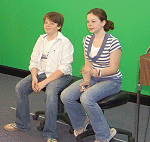 The daily newscast was the brainchild of Rob Zdrojewski’s,Amherst’s technology education teacher, who wanted a projectto complement his curriculum. He determined that amorning television show would suit his needs perfectly.Acquiring a $2,500 grant from Best Buy,he fashioned a studio from his 10-foot-by-12-foot office—byhis own estimate, putting in about a thousand volunteer hoursof labor on weekends, evenings, and school breaks. He thenbegan using Adobe Visual Communicatorto create the broadcasts. And he called the program Tech TV.
The daily newscast was the brainchild of Rob Zdrojewski’s,Amherst’s technology education teacher, who wanted a projectto complement his curriculum. He determined that amorning television show would suit his needs perfectly.Acquiring a $2,500 grant from Best Buy,he fashioned a studio from his 10-foot-by-12-foot office—byhis own estimate, putting in about a thousand volunteer hoursof labor on weekends, evenings, and school breaks. He thenbegan using Adobe Visual Communicatorto create the broadcasts. And he called the program Tech TV.
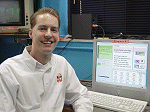 Students produce the daily news show. They sign up fornewscaster and behind-the-camera “intern” jobs; eventuallythey become senior producers. Currently Zdrojewski has sixsenior producers and five crews, one for each day of theschool week. The students show up at 8 in the morning androtate jobs: writing scripts, selecting graphics and music,operating camcorders, formatting graphics, directing, workingwith digital photography, setting up lighting, checking microphonelevels, designing backgrounds, and producing DVDs.They record each show live, and it is broadcast via a closedcircuitsystem to the rest of the school. Every student in theschool participates in the Tech TV program before graduating.The students learn skills in project management, teamwork,presentations, and writing, and Zdrojewski says that they gainan enormous amount of confidence.
Students produce the daily news show. They sign up fornewscaster and behind-the-camera “intern” jobs; eventuallythey become senior producers. Currently Zdrojewski has sixsenior producers and five crews, one for each day of theschool week. The students show up at 8 in the morning androtate jobs: writing scripts, selecting graphics and music,operating camcorders, formatting graphics, directing, workingwith digital photography, setting up lighting, checking microphonelevels, designing backgrounds, and producing DVDs.They record each show live, and it is broadcast via a closedcircuitsystem to the rest of the school. Every student in theschool participates in the Tech TV program before graduating.The students learn skills in project management, teamwork,presentations, and writing, and Zdrojewski says that they gainan enormous amount of confidence.
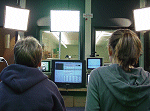 What’s next? Zdrojewski wants to send student reporters tosporting events and dances, and he wants to use Visual Communicator’sV-Screen Wizard to create virtual backgrounds,so that even if the reporters are in the studio, they’ll appear asif they’re on location.
What’s next? Zdrojewski wants to send student reporters tosporting events and dances, and he wants to use Visual Communicator’sV-Screen Wizard to create virtual backgrounds,so that even if the reporters are in the studio, they’ll appear asif they’re on location.
Ronda Stonecipher
San Marcos Consolidated IndependentSchool District (TX)
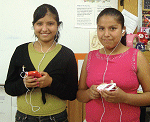 A news reporter asked a student from the San Marcos ConsolidatedIndependent School District, "What do you think havingan iPod has done for you? What are the benefits of having aniPod?" The student struggled with his answer, when his classmate,a 16-year-oldnew to this countryfrom India, scribbleda note on paper andhanded it to him. Thenote read: "It's likehaving a teacher inyour pocket."
A news reporter asked a student from the San Marcos ConsolidatedIndependent School District, "What do you think havingan iPod has done for you? What are the benefits of having aniPod?" The student struggled with his answer, when his classmate,a 16-year-oldnew to this countryfrom India, scribbleda note on paper andhanded it to him. Thenote read: "It's likehaving a teacher inyour pocket."
Can there be a better description of what iPods have meant to the students in this central Texas school district? The district gives out between 225 and 300 iPods annually, for use at school and home, to deaf-education students in grades 3 and 4 (the teachers record themselves signing, use iMovie to add closed captioning, and record their voices—that way, the students' parents can help them); special education students in grades 5 and 6; and newcomers—students learning English as a second language—in grades 7 to 12.
Ronda Stonecipher, the district's director of instructional technology, says that the iPod project "is an effort to prevent students from sitting lost in class and not graduating."
Teachers load the iPods with supporting curriculum materials that are suited to each student's grade level, providing students with the opportunity to create projects, videos, audio, and other content for all their courses. The devices are improving communication between home and school, and even students and parents, as they allow classwork content to be seen and shared. The training is minimal: Stonecipher spends about 30 minutes a day with teachers who are digital immigrants, and little or no time with those who are comfortable with the technology. The results from 2006-2007, the project's first year, are encouraging.
"What we found is that the students who had the iPods made progress immediately," says Stonecipher. "Their grades for the most part went up at least one grade level." She also notes that students felt much more confident in class, were better able to apply the language skills they'd acquired, and performed at a higher rate on standardized tests.
"We can't afford not to provide this for our students," she says. "We need all our students to be successful."
John Concilus
Bering Strait School District (AK)
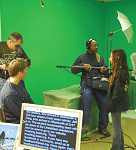 At last year's Iditarod,the annual Alaskandog sledding race,renowned musher JeffKing, the eventualwinner, pulled into theUnalakleet checkpoint,700 miles down theroad from the start.Exhausted, he wateredand fed his dogs, andthen came out to meetthe media, including acohort from ABC's Nightline. "I have time for only one interview," he said, andproceeded to give that interview to students from the BeringStrait School District.
At last year's Iditarod,the annual Alaskandog sledding race,renowned musher JeffKing, the eventualwinner, pulled into theUnalakleet checkpoint,700 miles down theroad from the start.Exhausted, he wateredand fed his dogs, andthen came out to meetthe media, including acohort from ABC's Nightline. "I have time for only one interview," he said, andproceeded to give that interview to students from the BeringStrait School District.
The interview was broadcast online as part of BSSD's IditaProject, which connects schools and students outside Alaska with the district's multifaceted coverage of the famed race. The project was started five years ago by John Concilus, Bering Strait's educational technology coordinator, as an extension of a regular unit about dog mushing in the region that was part of the district's curriculum for many years. BSSD has more villages with schools along the Iditarod Trail than any other in the state of Alaska. Concilus says the project uses the Iditarod race as "an opportunity for our students to teach outside audiences about our regional history and culture while learning the skills needed to communicate using new technologies."
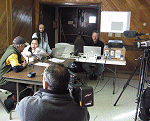 The race coverage is conducted by members of the district's Student Broadcasting Team and is anchored out of Unalakleet, a village in western Alaska. SBT members carry regular press credentials issued by the Iditarod Trail Committee, just like the professional press crews. They conduct interviews, record digital video, take pictures, and issue vodcast, audio, image, and blog updates on happenings along the trail, including twice-daily five-minute broadcasts starting the Monday after the start of the race, and continuing until the last musher is across the finish line. Roughly 8,000 students in 170 schools contributed to the 2007 race coverage.
The race coverage is conducted by members of the district's Student Broadcasting Team and is anchored out of Unalakleet, a village in western Alaska. SBT members carry regular press credentials issued by the Iditarod Trail Committee, just like the professional press crews. They conduct interviews, record digital video, take pictures, and issue vodcast, audio, image, and blog updates on happenings along the trail, including twice-daily five-minute broadcasts starting the Monday after the start of the race, and continuing until the last musher is across the finish line. Roughly 8,000 students in 170 schools contributed to the 2007 race coverage.
In addition to the daily race updates, 12 live, two-hour broadcasts spread over six days integrate the district's curricular content into the reporting. Special guests such as veterinarians, race officials, trail rangers, and pilots are interviewed by BSSD students and teachers about several aspects of the race, providing educational content on such topics as cultural and historical factors, mushing math and logistics, and veterinary medicine.
These lessons function internally as part of BSSD's curriculum, but the district uses the setting of the Iditarod as an annual educational outreach effort to give students an authentic audience. New this year, participating schools will be able to use wiki-based curriculum tools to collaborate online in building a common thematic unit.
The project is an ideal merging of technology and learning. "Students and staff producing these curriculum units learn about their own communities, culture, and history, as well as acquire the technology skills required to produce new media content for the web," Concilus says. "This truly is place-based education at its most powerful."